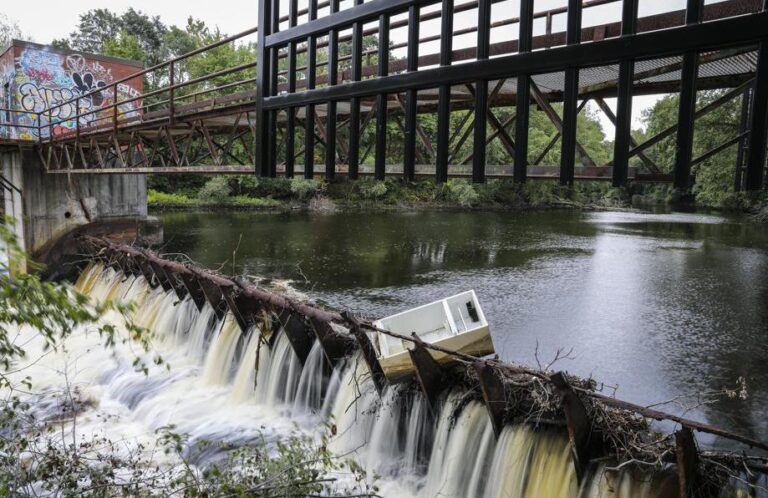Drinking water quality, environmental disaster responses, and river pollution cleanups could be compromised, former environmental regulators warn, if the Trump administration’s goal to slash the nation’s environmental agency by more than half is successful.
President Trump said earlier this week that the staff of the Environmental Protection Agency, which is charged with ensuring the US has clean water, clean air, and a safe environment, could be cut by 65 percent. On Thursday, a White House spokesperson said the figure actually referred to planned spending cuts for the agency.
Either way, former regional EPA administrators told the Globe that such a drastic and historic reduction would hurt the EPA’s core mission to clean up and prevent pollution. In New England, it could mean stalling the work to remediate rivers, a halt in the effort to prevent and clean up pervasive “forever’’ chemicals in drinking water, and increased pollution into the Boston Harbor.
The EPA currently has a staff of about 16,000 and a budget around $11 billion, representing less than 1 percent of the federal government’s total spending. A 65 percent cut to the agency’s budget would reduce it to about $4 billion, an appropriations move that would require congressional approval.
“Eliminating 65 percent of the EPA’s wasteful spending will help the agency focus its resources on addressing environmental disasters while cutting government bloat,’’ said Taylor Rogers, a spokesperson for the White House, in a statement.
The EPA did not respond to a request for comment on the potential cut.
State environmental agencies would be devastated by such a large cut. Almost half of the EPA’s budget flows directly to states and tribes to enact the nation’s environmental laws.
Federal spending makes up a third of the Massachusetts Department of Environmental Protection’s budget, for example. The money funds the testing of drinking water for lead in school and child-care facilities, inspections of the sources of air pollution, monitoring pollution in bodies of water, and more.
“We continue to work with the EPA and monitor any potential changes in federal funding,’’ Fabienne Alexis, spokesperson for the Department of Environmental Protection, wrote in a statement. “Any cutback in funding from the Trump Administration will have far-reaching consequences, hitting small and low-income communities the hardest.’’
David Cash, the former regional administrator for the New England’s EPA office under President Biden, warned that such a “devastating’’ cut, as he described it, would hamper the day-to-day monitoring of water systems and could result in EPA being caught flatfooted during environmental emergencies.
“Cities, towns and states couldn’t count on EPA to step up and help solve major environmental emergencies when they happen,’’ Cash said.
A weaker environmental disaster response could even result in injuries and exposure to toxic chemicals, Cash said, pointing out that EPA staff responded to an industrial fire at a potato processing plant in Belfast, Maine, in 2022 and supervised water quality in Vermont during last year’s severe flash floods.
The EPA’s regional staff are among the first responders to environmental emergencies like those, monitoring the air for dangerous chemicals after industrial fires and ensuring water is safe to drink after severe storms overwhelm infrastructure.
Brad Campbell, president of the Conservation Law Foundation, an environmental law nonprofit in New England, said that “the public will be at peril of toxic pollution’’ if such dramatic cuts to EPA are enacted.
Campbell, a former EPA regional administrator for the Mid-Atlantic region, said a 65 percent cut would be dramatic enough to jeopardize government responses to oil spills and compromise the science needed to ensure drinking water is safe.
New England’s regional EPA office had planned, under Biden, to more aggressively regulate storm water pollution washing into Boston-area watersheds from industrial facilities and parking lots. With the EPA cuts proposed by the Trump Administration, however, Campbell thinks those stricter regulations are unlikely to be enacted, which could mean “more outbreaks of toxic algae’’ in the rivers due to the pollution, he said.
Michelle Roos, executive director of the Environmental Protection Network, an organization of former EPA staff that advocate for environmental protections, said the plan would be the equivalent of a “wrecking ball’’ to the agency and leave the doors “wide open’’ for polluters.
“A 65 percent cut would gut the agency, and bring EPA to the lowest levels of staffing since EPA was created in 1970, when the skies were dark with smog [and] toxic rivers caught fire,’’ she said.
President Trump also attempted to make drastic EPA cuts during his first term. At that time, Congress rejected such big reductions; Campbell and others are hoping that will be the case again.
“All eyes are on Susan Collins,’’ he said, naming the Republican senator from Maine who is the chair of the appropriations committee. “In the past, she hasn’t had an appetite for deep cuts to [the] EPA.’’
“We’re hoping that she will stand firm in protecting the basic safeguards of our health and environment.’’
Collins has championed some environmental issues in the past, particularly improving water quality. She recently urged the federal government to do more to clean up PFAS contamination, a group of long-lasting and widely used industrial chemicals polluting the water, air, fish, and soil. Last year, Collins introduced a bill to address PFAS water contamination in the wells of private homeowners. (More than half of Maine residents get drinking water from private wells.)
One of Trump’s executive orders has already effectively halted an EPA plan to limit industrial pollution of the “forever chemicals’’ into waterways.
It’s unclear how Collins, whose office did not respond to a request for comment, will react to aggressive federal budget cuts to the EPA. She was also one of the lead negotiators of the Infrastructure, Investment, and Jobs Act, which allocated billions of dollars toward climate and environment projects, particularly for improving water quality across the country.
The legislation directed $254 million to Maine to upgrade the state’s drinking water and wastewater infrastructure.
Erin Douglas can be reached at erin.douglas@globe.com. Follow her @erinmdouglas23.

